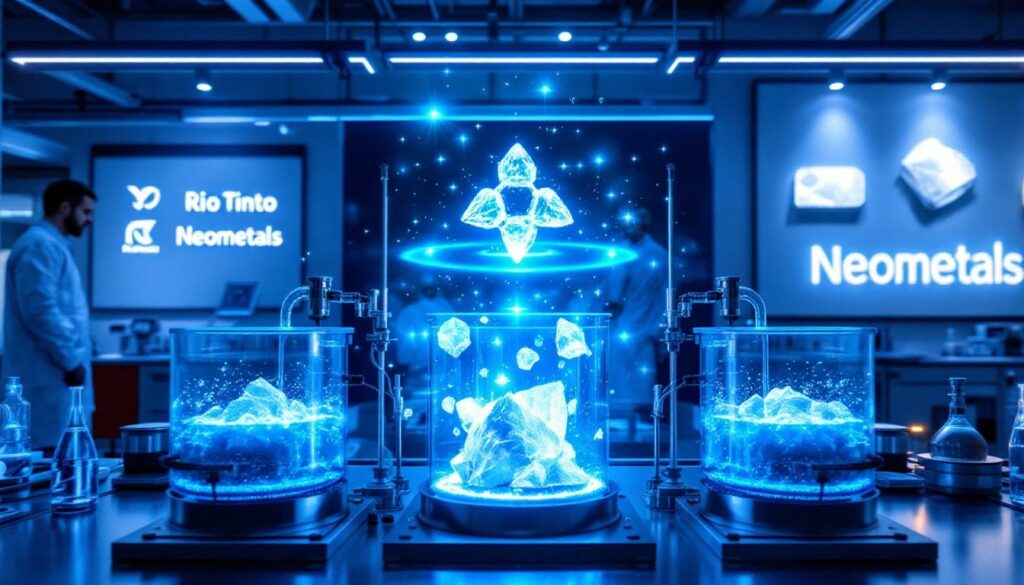What is the ELi Process Technology?
The ELi Process Technology represents a revolutionary advancement in lithium processing that could transform how battery-grade materials are produced globally. Unlike conventional methods that rely heavily on chemical reagents, ELi harnesses electrochemical principles to create a more efficient, environmentally conscious approach to lithium hydroxide production.
The Electrochemical Revolution in Lithium Processing
At its core, the ELi Process utilizes electricity to convert lithium chloride solutions directly into lithium hydroxide through a conventional chlor-alkali cell system. This electrochemical approach marks a significant departure from traditional chemical precipitation methods that dominate the industry today.
"The ELi Process completely eliminates the need for large volumes of bulk chemical reagents," explains Chris Reed, Managing Director of Neometals. "This has the potential to deliver a step-change in operating costs versus industry-standard chemical precipitation methods."
The technology works by passing an electrical current through a specialized membrane system that facilitates the conversion of lithium chloride to lithium hydroxide without the intermediate chemical steps required in conventional processing. This direct lithium extraction boost not only simplifies the production process but potentially reduces both capital and operating expenditures significantly.
Technical Advantages That Drive Industry Interest
The ELi Process offers several distinct advantages that have attracted attention from major players like Rio Tinto:
-
Chemical Independence: By eliminating reliance on bulk reagents like sodium carbonate, sulfuric acid, and lime, ELi reduces supply chain vulnerabilities and price volatility exposure.
-
Simplified Process Flow: The electrochemical approach requires fewer processing steps, potentially reducing equipment requirements and physical plant footprint.
-
Energy Efficiency: While the process requires electricity, the overall energy consumption compares favorably to conventional methods when accounting for reagent production and transportation energy costs.
-
Product Purity: Electrochemical processes can potentially deliver higher purity lithium hydroxide with fewer impurities, critical for advanced battery applications.
-
Environmental Footprint: Reduced chemical usage translates to lower transportation emissions, fewer waste streams, and diminished water consumption requirements.
Industry experts note that electrochemical processes like ELi represent the next generation of lithium processing technology—moving beyond the chemical-intensive methods developed decades ago toward more sustainable, efficient approaches aligned with the growing demands of the battery industry.
Why Are These Companies Collaborating on Lithium Technology?
The partnership between Neometals, Mineral Resources, and Rio Tinto brings together complementary strengths in a strategic alliance that could accelerate the commercialization of advanced lithium processing technology at a critical time for the battery metals investment sector.
Strategic Alignment of Capabilities and Resources
Reed Advanced Materials (RAM), co-owned by Neometals (70%) and Mineral Resources (30%), has developed the innovative ELi Process Technology through years of research and development. However, bringing such technology to commercial scale requires significant resources, technical expertise, and market connections—areas where Rio Tinto excels.
"Rio Tinto is a global leader in energy transition commodities with scale, development capabilities, and financial strength," notes Chris Reed. "We are naturally excited to collaborate with Rio Tinto and are confident ELi can be an ideal complement to Rio's direct lithium extraction technologies."
This collaboration creates a powerful synergy:
- Technology Innovation: RAM brings cutting-edge electrochemical processing technology
- Development Capacity: Rio Tinto contributes engineering and scaling expertise
- Financial Resources: Access to capital necessary for commercialization
- Market Presence: Rio Tinto's global connections and customer relationships
- End-to-End Integration: Potential to combine with Rio's extraction technologies
Industry Context Driving Collaboration
The timing of this partnership reflects broader industry dynamics pushing toward more efficient lithium processing:
- Battery Demand Surge: Electric vehicle and energy storage growth creating unprecedented demand for battery-grade lithium hydroxide
- Cost Pressures: Increasing competition requiring process innovations to maintain margins
- Sustainability Requirements: Growing ESG expectations from investors, customers, and regulators
- Supply Chain Security: Strategic need to develop more resilient processing capabilities
- Australian Industry Development: National interest in moving up the battery materials value chain
This collaboration represents a strategic response to these market forces—bringing together Australian innovation with global resources to potentially reshape lithium processing economics.
How Will the Technology Validation Process Work?
The path from innovative technology to commercial implementation involves rigorous validation steps, and the Memorandum of Understanding (MoU) between RAM and Rio Tinto outlines a methodical approach to advancing the ELi Process Technology.
Structured Development Pathway
According to the agreement outlined in June 2025, the validation process will progress through several defined stages:
-
Optimization Test Work: RAM will conduct detailed laboratory testing to refine and optimize the electrochemical processes, focusing on efficiency, stability, and output quality.
-
Process Design Updates: Technical parameters will be updated based on test results, creating detailed specifications for scaling the technology.
-
Pilot or Demonstration Planning: Following successful optimization, discussions will focus on developing a pilot-scale facility to validate the technology under more realistic conditions.
-
Real-World Application Testing: The ultimate goal involves testing the ELi Process in conjunction with Rio Tinto's emerging lithium processing technologies in actual production environments.
-
Funding Structure: The MoU indicates Rio Tinto may fund the optimization work and process design updates, reflecting their strategic interest in the technology.
"This structured approach allows for systematic de-risking of the technology before significant capital is committed to commercial-scale implementation," notes an industry analyst familiar with battery materials processing technologies.
Critical Technical Validation Parameters
The validation process will focus on several key performance indicators:
- Conversion Efficiency: Measuring the percentage of lithium chloride successfully converted to lithium hydroxide
- Energy Consumption: Quantifying electricity requirements per tonne of lithium hydroxide produced
- Product Purity: Validating that output meets or exceeds battery-grade specifications (>99.5% LiOH)
- Process Stability: Assessing consistency and reliability during continuous operation
- Membrane Performance: Evaluating durability and maintenance requirements of critical components
- Scalability Factors: Identifying any challenges in scaling from laboratory to commercial implementation
This validation framework reflects industry best practices for de-risking new process technologies before commercial deployment, balancing innovation with technical prudence.
What Are the Potential Industry Impacts of This Technology?
The successful commercialization of the ELi Process Technology could have far-reaching implications for the lithium industry, potentially reshaping cost structures, competitive dynamics, and environmental footprints across the battery materials value chain.
Economic Transformation of Lithium Processing
According to Neometals' Managing Director Chris Reed, the ELi Process "has the potential to deliver a step-change in operating costs versus industry-standard chemical precipitation." This assessment suggests significant economic advantages:
-
Reagent Elimination: Traditional lithium hydroxide production requires substantial quantities of soda ash, sulfuric acid, and caustic soda—all costly inputs subject to price volatility.
-
Simplified Logistics: Reduced chemical inputs translate to fewer transportation requirements, lower storage costs, and simplified supply chain management.
-
Process Intensification: Electrochemical methods potentially allow for more compact plant designs with higher throughput per square meter.
-
Operational Flexibility: The ability to rapidly adjust production rates based on electricity availability and market demand.
Industry analysts suggest that reagent costs can represent 40-60% of operating expenses in conventional lithium hydroxide production, indicating the magnitude of potential savings through electrochemical approaches.
Integration with Direct Lithium Extraction
One of the most promising aspects of the ELi technology is its potential complementarity with Rio Tinto's direct lithium extraction (DLE) methods, as highlighted by Chris Reed who noted "ELi can be an ideal complement to Rio's direct lithium extraction technologies."
This integration could create several strategic advantages:
-
Streamlined Processing Chain: DLE typically produces lithium chloride solutions—the ideal feedstock for ELi's electrochemical conversion.
-
Reduced Intermediate Steps: Elimination of carbonate precipitation steps that often connect extraction and hydroxide production.
-
Consistent Quality Control: End-to-end process integration allows for better quality management and fewer contamination risks.
-
Optimized Water Management: Potential for water recycling between extraction and conversion processes.
The combination of advanced extraction and conversion technologies could represent a next-generation approach to lithium production with improved economics and environmental performance compared to conventional methods.
Competitive Positioning and Market Differentiation
Companies successfully implementing the ELi technology could gain significant competitive advantages:
-
Cost Leadership: Lower operating costs could improve margins or enable more competitive pricing.
-
Environmental Differentiation: Reduced chemical usage and potentially lower carbon footprint align with growing ESG requirements from battery and EV manufacturers.
-
Supply Chain Resilience: Decreased dependence on chemical reagents reduces vulnerability to supply disruptions and price volatility.
-
Product Consistency: Electrochemical processes potentially offer more precise control over product specifications.
As battery manufacturers increasingly focus on sustainability and stable supply chains, processing innovations like ELi may become key differentiators in supplier selection and long-term contracting.
What Other Projects Are Neometals Pursuing?
While the ELi Process Technology represents a significant focus for Neometals, the company maintains a diversified portfolio that includes promising developments in precious metals exploration, particularly its Barrambie Gold Project in Western Australia.
Barrambie Gold Project Developments
Neometals recently announced its first Mineral Resource Estimate for the Ironclad prospect within its 100%-owned Barrambie project, revealing promising gold mineralization:
- Resource Quantification: Approximately 250,000 tonnes of mineralized material
- Grade Profile: Average grade of 1.6 grams per tonne gold
- Contained Metal: Estimated 13,000 ounces in the inferred resource category
- Exploration Methods: Resource based on shallow reverse circulation and rotary air blast drilling
- Historical Context: Located in the vicinity of historic underground workings
This initial resource represents just one area within the broader Barrambie project, which has historically been explored primarily for its titanium and vanadium potential. The identification of economically interesting gold mineralization adds a new dimension to the project's value proposition.
The Ironclad prospect resource, while modest in size, is significant as it:
- Demonstrates gold mineralization potential across the broader project area
- Provides a starting point for systematic expansion of gold resources
- Offers potential for near-term development with relatively low capital requirements
- Creates valuable diversification within Neometals' asset portfolio
Strategic Portfolio Diversification
Neometals' simultaneous advancement of lithium processing technology and gold exploration reflects a deliberately balanced approach to resource development:
- Technology vs. Traditional Mining: Balancing innovation-driven growth with conventional resource development
- Battery Materials vs. Precious Metals: Exposure to both energy transition metals and counter-cyclical gold
- Development Timelines: Mix of near-term (gold) and medium-term (lithium technology) revenue potential
- Risk Profile Management: Distributing investment across different commodity and technology risk profiles
This strategic diversification positions Neometals to potentially benefit from multiple market cycles while continuing to advance its core technology initiatives. The company's willingness to explore gold potential at Barrambie while simultaneously pushing forward lithium processing innovation demonstrates a pragmatic approach to resource sector investment.
Industry analysts note that this type of diversification strategy has become increasingly important in the resource sector, particularly for companies with significant exposure to battery materials markets that can experience volatility as supply and demand dynamics evolve.
What Does This Partnership Mean for Australia's Battery Materials Sector?
The collaboration between Neometals, Mineral Resources, and Rio Tinto to advance the ELi Process Technology carries significant implications for Australia's position in global battery supply chains and its broader resource strategy.
Climbing the Battery Value Chain
Australia has long been a dominant player in lithium raw material production, supplying approximately 55% of global lithium through operations in Western Australia. However, the country has historically captured relatively little of the downstream processing value, with less than 1% of lithium refining occurring domestically.
The ELi technology partnership represents a strategic opportunity to address this imbalance:
- Value Capture: Moving beyond raw material exports to higher-value lithium hydroxide production
- Intellectual Property Development: Creating Australian-owned processing technology with global application potential
- Technical Capability Building: Developing domestic expertise in advanced chemical processing
- Supply Chain Positioning: Establishing Australia as more than just a raw material supplier
This evolution aligns with Australia lithium innovations and Critical Minerals Strategy, which explicitly aims to move the country up the value chain from extraction to processing and manufacturing of battery materials.
Creating Competitive Advantages
The development of proprietary processing technology could provide Australia with several strategic advantages in the global battery materials market:
- Processing Economics: Potentially lower-cost conversion methods could make Australian processing globally competitive despite higher labor and energy costs
- Quality Differentiation: Advanced electrochemical processes may produce superior battery-grade materials
- Integration Benefits: Combining domestic mining with innovative processing creates logistical advantages
- Sustainability Leadership: Reduced chemical usage aligns with growing demands for environmentally responsible production
These advantages could help Australia overcome traditional barriers to downstream processing, including high domestic costs and distance from major battery manufacturing centers.
Building a Battery Materials Ecosystem
The RAM-Rio Tinto partnership contributes to a growing ecosystem of battery materials initiatives across Australia:
- Research Collaboration: Connecting mining companies with technology developers and research institutions
- Skills Development: Creating demand for electrochemical engineering and advanced manufacturing capabilities
- Supporting Industries: Encouraging growth in specialty chemical production, analytical services, and engineering design
- Investment Attraction: Demonstrating Australia's commitment to battery supply chain development
By advancing innovative processing technologies like ELi, Australia positions itself as a more comprehensive player in global battery supply chains rather than simply a supplier of raw materials—a strategic repositioning that could generate significant long-term economic benefits as the energy transition accelerates alongside new developments in battery-grade lithium refinery technologies globally.
FAQs About the ELi Process Technology Partnership
What makes the ELi Process different from conventional lithium processing?
The fundamental difference lies in the method of conversion. Conventional lithium hydroxide production typically relies on a chemical precipitation approach that requires substantial quantities of reagents including soda ash (Na₂CO₃), sulfuric acid (H₂SO₄), and lime (CaO). These chemicals react with lithium-bearing solutions in a multi-step process to produce lithium hydroxide.
In contrast, the ELi Process employs an electrochemical approach using a chlor-alkali cell system. This system directly converts lithium chloride solutions into lithium hydroxide using electricity rather than chemical reagents. The process essentially separates chloride ions from lithium ions across a specialized membrane, allowing for direct hydroxide formation without the intermediate steps and chemical consumption of conventional methods.
This electrochemical approach eliminates the need for bulk chemical reagents, simplifies the process flow, and potentially reduces both capital and operating expenses significantly.
How might this technology affect lithium production costs?
According to Neometals' Managing Director Chris Reed, the ELi Process "has the potential to deliver a step-change in operating costs versus industry-standard chemical precipitation." While specific cost reduction figures haven't been publicly disclosed, the impact could be substantial based on the current cost structure of lithium hydroxide production:
-
Reagent Elimination: Chemical reagents typically represent 40-60% of operating costs in conventional lithium hydroxide production, suggesting significant potential savings.
-
Logistical Simplification: Reduced chemical handling, storage, and transportation requirements could lower both capital and operating expenses.
-
Process Efficiency: Fewer processing steps may reduce labor requirements, maintenance costs, and production losses.
-
Energy Considerations: While electrochemical processes require electricity, the net energy balance may be favorable when considering the energy embedded in reagent production and transportation.
The actual cost impact will depend on successful scale-up, electricity costs in the implementation location, and process optimization outcomes from the validation work.
What stage of development is the ELi Process currently in?
The ELi Process has progressed beyond initial concept and laboratory proof-of-concept stages but requires further validation before commercial implementation. According to the MoU announced in June 2025, the current development stage focuses on optimization test work and process design updates.
The technology development pathway includes:
- Completed Stages: Initial concept development, laboratory-scale proof of concept, preliminary process design
- Current Focus: Optimization test work, process design refinement
- Next Phases: Pilot or demonstration-scale implementation, integration testing with Rio Tinto's extraction technologies
- Future Steps: Commercial-scale design, construction, and operation
The partnership with Rio Tinto represents an important step toward commercialization, providing potential funding for optimization work and access to development expertise necessary for scaling the technology.
How does this partnership benefit each company involved?
The collaboration creates specific strategic advantages for each participating company:
For Neometals (70% owner of RAM):
- Access to Rio Tinto's technical expertise and development capabilities
- Potential funding for technology advancement
- Pathway to commercial implementation and technology validation
- Enhanced credibility through association with a major mining company
Ready to Catch the Next Major Mining Discovery?
Gain immediate alerts on significant ASX mineral discoveries with Discovery Alert's proprietary Discovery IQ model, turning complex mineral data into actionable investment insights for both short and long-term opportunities. Explore why major mineral discoveries lead to exceptional market returns by visiting Discovery Alert's dedicated discoveries page and begin your 30-day free trial today.




